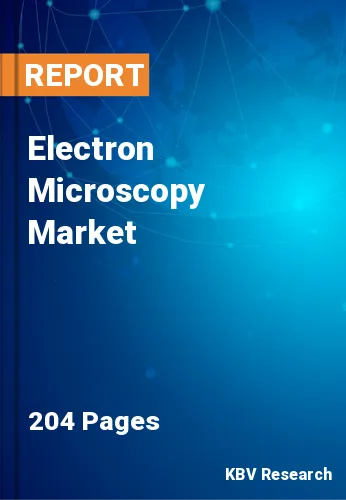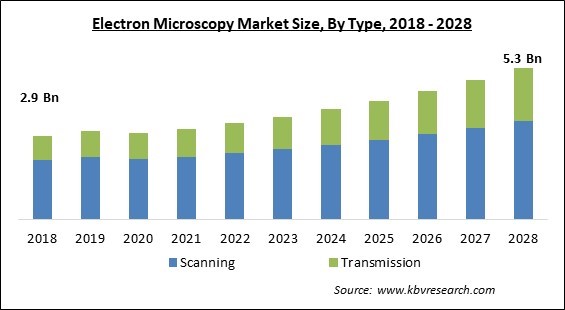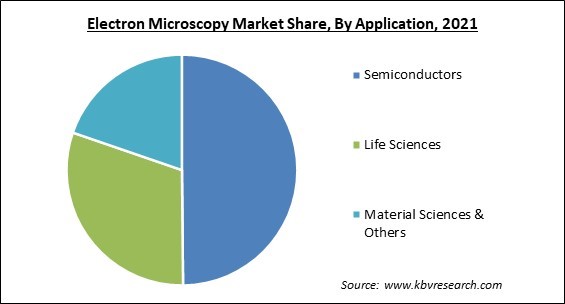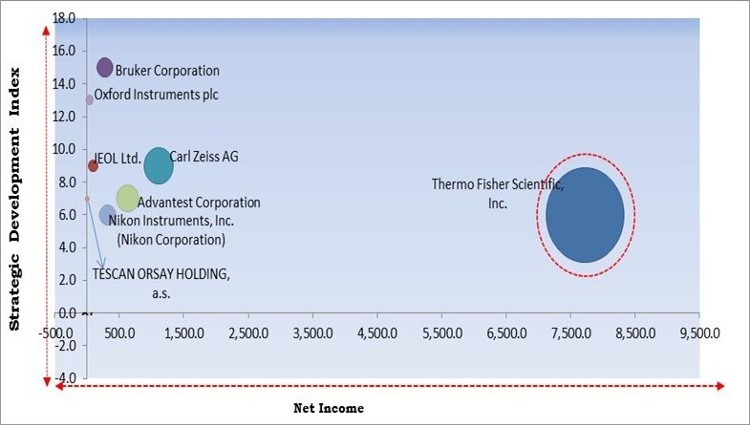
The Global Electron Microscopy Market size is expected to reach $5.3 billion by 2028, rising at a market growth of 7.8% CAGR during the forecast period.
Electron microscopy (EM) is a technique for taking high-resolution pictures of both biological and non-biological material. It is employed in biomedical research to look at the precise structure of organelles, macromolecular complexes, tissues, cells, and cells. The utilization of electrons as the source of illuminating radiation, which has extremely short wavelengths, contributes to the great resolution of EM pictures. To address particular issues, electron microscopy is combined with a range of auxiliary methods (such as thin sectioning, immuno-labeling, and negative staining.

For traditional scanning electron microscopy to work, secondary electrons must be emitted from a specimen's surface. A scanning electron microscope is the equivalent of a stereo light microscope in the EM because of its superior depth of focus. It offers intricate pictures of the surfaces of cells and entire organisms, which TEM cannot do. Additionally, it can be utilized for process control, particle size analysis, and counting. Because the image is created by rastering a focused electron beam across the specimen's surface, it is known as a scanning electron microscope.
Each point in the raster emits particles as a result of the primary electron beam's interaction with atoms close to the surface low energy secondary electrons, high-energy backscatter electrons, X-rays, and even photons. These can be gathered using a variety of detectors, and the brightness at each analogous position on a cathode ray tube can be calculated from their relative number. The final image is an enlarged image of the specimen since the size of the raster at the specimen is significantly smaller than the viewing screen of the CRT. SEMs that are properly set up (with secondary, backscatter, and X-ray detectors) can be used to examine specimen topography, atomic composition, as well as, the distribution of immuno-labels on the specimen's surface.
Trade and economic activity have been impacted by the COVID-19 outbreak everywhere in the world. While the small software industry for the automotive and aerospace industries is expected to suffer, the tiny software market for the healthcare and semiconductor industries is expected to grow. Production and manufacturing have been significantly impacted as a result of several countries around the world declaring statewide lockdowns and temporary closures of various industries. Trade restrictions have made the demand-supply mismatch worse. The COVID-19 pandemic will affect companies that make semiconductors for the electron microscope market in a variety of ways, both now and in the future.
Digitization, super-resolution, live-cell imaging, and high throughput techniques are examples of technological developments in microscopy. These advancements contribute to lower product and testing costs. A number of microscopes have developed recently, including expansion microscopes, scanning helium microscopes (SHeM), multi-view microscopes, and integrated microscopy systems. Among the most recent developments in electron microscopy and sample preparation is digital microscopy. Better sample viewing and fewer distorted images are produced by digital imaging's greater image resolution and precision. The creation of complete slide scanning equipment has accelerated the adoption of digital microscopy.

The shortest wavelength of visible light, or about 0.4 micrometers, is the largest item that a scientist can view through a light microscope. Any object smaller than that in diameter won't reflect light and won't be seen by light-based equipment. These tiny items include individual atoms, molecules, and virus particles, to name a few. Because they do not rely on light from the visible spectrum to be reflected by them, electron microscopes may produce images of these objects. Instead, the sample being investigated is bombarded with high-energy electrons, and an image is created using information about how these electrons behaved as they were reflected and deflected by the sample.
Standard compound microscopes are simple for physicists and lab professionals to use, but as sophisticated microscopes are developed, trained personnel are needed. For instance, to study the characterization of chemical and biological compounds at the atomic or molecular level, atomic force scanning tunneling microscopes widely used in nanotechnology require physicists or technicians to have in-depth interdisciplinary knowledge in the area of surface physics and surface analyses. A particularly sensitive piece of technology, an electron microscope can be severely harmed by external magnetic fields and vibrations. It must be kept in working order by experienced personnel in a dedicated space.
On the basis of type, the Electron Microscopy Market is divided into Scanning and Transmission. The scanning segment acquired the highest revenue share in the electron microscopy market in 2021. it is because a focused stream of high-energy electrons is utilized by scanning electron microscopes (SEMs) to produce a range of signals at the surface of solid samples. Up to 100,000x of magnification is possible with SEMs. These microscopes create 3-dimensional images with a high depth of field, high resolution (less resolution than TEMs), and information on the topography, morphology, and composition of objects.
Based on the Application, the Electron Microscopy Market is classified into Semiconductors, Life Sciences, Material Sciences & Others. The life sciences segment recorded a substantial revenue share in the electron microscopy market in 2021. Biological samples are the primary focus of life science electron microscopy. This also applies to medicine development, viral testing, and testing for the food and beverage business. The subject of molecular and cellular biology in medicine has made strides because of high technology.
By End-user, the Electron Microscopy Market is bifurcated into Industries, Academic & Research Institutes, and Others. The industries segment garnered the highest revenue share in the electron microscopy market in 2021. It is because pharmaceutical and biotechnology, semiconductor and electronics, textiles, mining, and material science, and natural resources (oil and gas) industries are all included in the industries segment's preview. When developing and producing semiconductors and other types of electronics, the electronics industry uses electron microscopes for high-resolution imaging.
| Report Attribute | Details |
|---|---|
| Market size value in 2021 | USD 3.2 Billion |
| Market size forecast in 2028 | USD 5.3 Billion |
| Base Year | 2021 |
| Historical Period | 2018 to 2020 |
| Forecast Period | 2022 to 2028 |
| Revenue Growth Rate | CAGR of 7.8% from 2022 to 2028 |
| Number of Pages | 204 |
| Number of Tables | 343 |
| Report coverage | Market Trends, Revenue Estimation and Forecast, Segmentation Analysis, Regional and Country Breakdown, Competitive Landscape, Companies Strategic Developments, Company Profiling |
| Segments covered | Type, Application, End User, Region |
| Country scope | US, Canada, Mexico, Germany, UK, France, Russia, Spain, Italy, China, Japan, India, South Korea, Singapore, Malaysia, Brazil, Argentina, UAE, Saudi Arabia, South Africa, Nigeria |
| Growth Drivers |
|
| Restraints |
|
Region-wise, the Electron Microscopy Market is analyzed across North America, Europe, Asia Pacific, and LAMEA. The Asia pacific region acquired a promising revenue share in the electron microscopy market in 2021. The Asia Pacific is fueled due to the factors such as the rising R&D funding for microscopy research, expanding use of correlative microscopy in life science and nanotechnology research, the establishment of collaboration centers for microscopy research, and the affordability of raw materials and skilled labor for OEMs.
Free Valuable Insights: Global Electron Microscopy Market size to reach USD 5.3 Billion by 2028

The major strategies followed by the market participants are Product Launches. Based on the Analysis presented in the Cardinal matrix; Thermo Fisher Scientific, Inc. is the forerunners in the Electron Microscopy Market. Companies such as Advantest Corporation, Carl Zeiss AG, Bruker Corporation are some of the key innovators in Electron Microscopy Market.
The market research report covers the analysis of key stake holders of the market. Key companies profiled in the report include Bruker Corporation, Carl Zeiss AG, Thermo Fisher Scientific, Inc., JEOL Ltd., Nikon Instruments, Inc. (Nikon Corporation), Hitachi High-Technologies Corporation (Hitachi Ltd.), Oxford Instruments plc, TESCAN ORSAY HOLDING, a.s., Delong Instruments AS, and Advantest Corporation.
By Type
By Application
By End User
By Geography
The global Electron Microscopy Market size is expected to reach $5.3 billion by 2028.
Improvements In Microscopy Technology are driving the market in coming years, however, Lack Of Professional Expertise restraints the growth of the market.
Bruker Corporation, Carl Zeiss AG, Thermo Fisher Scientific, Inc., JEOL Ltd., Nikon Instruments, Inc. (Nikon Corporation), Hitachi High-Technologies Corporation (Hitachi Ltd.), Oxford Instruments plc, TESCAN ORSAY HOLDING, a.s., Delong Instruments AS, and Advantest Corporation.
The expected CAGR of the Electron Microscopy Market is 7.8% from 2022 to 2028.
The Semiconductors segment acquired maximum revenue share in the Global Electron Microscopy Market by Application 2021 thereby, achieving a market value of $2.6 billion by 2028.
The North America market dominated the Global Electron Microscopy Market by Region 2021, and would continue to be a dominant market till 2028; thereby, achieving a market value of $1.8 billion by 2028.
Our team of dedicated experts can provide you with attractive expansion opportunities for your business.
